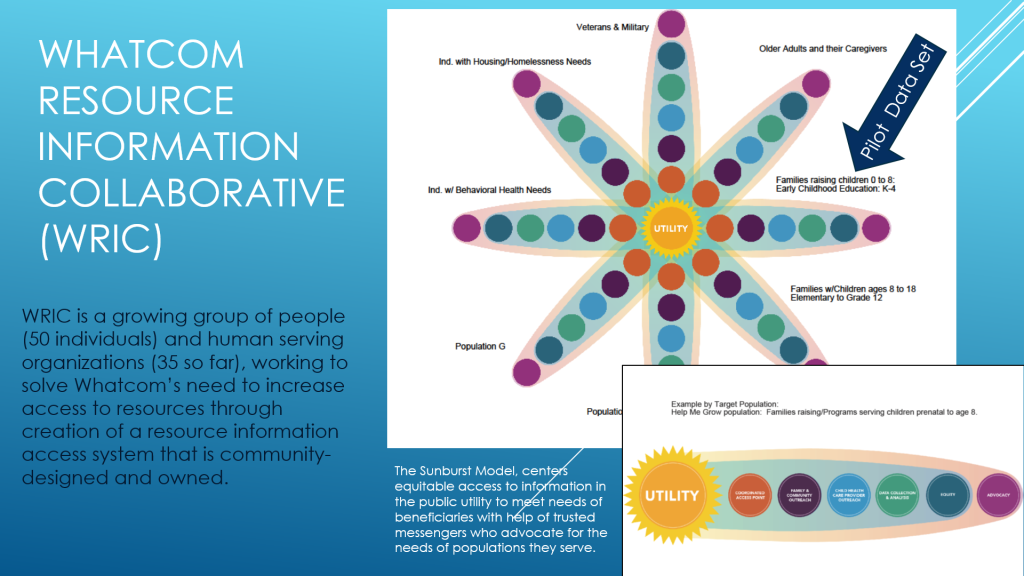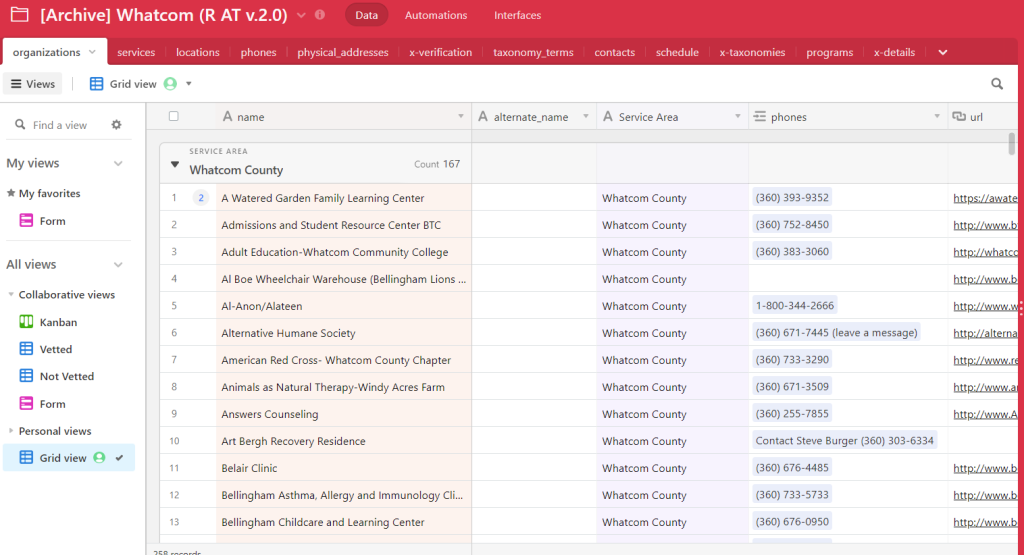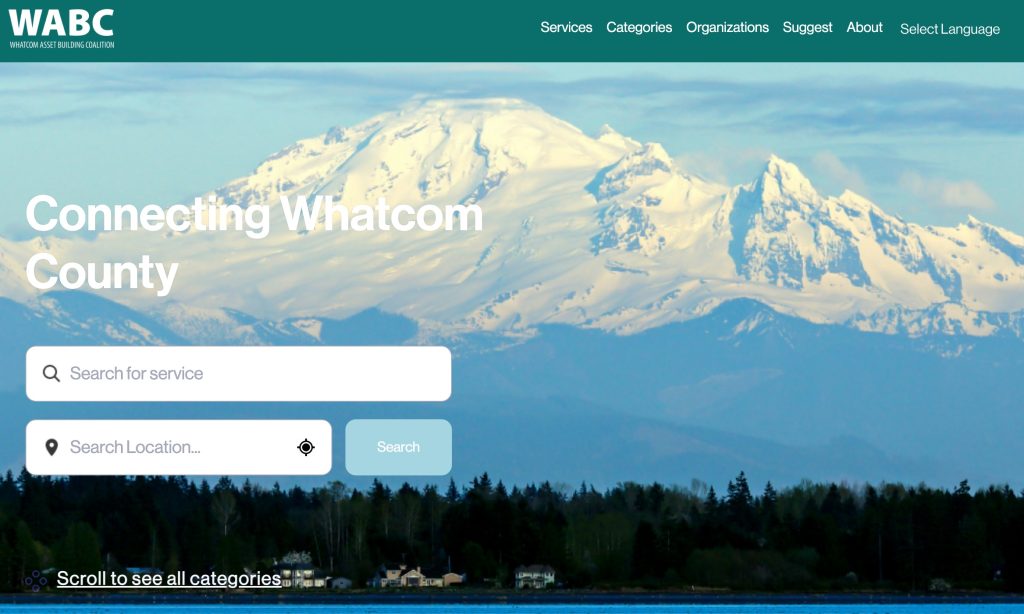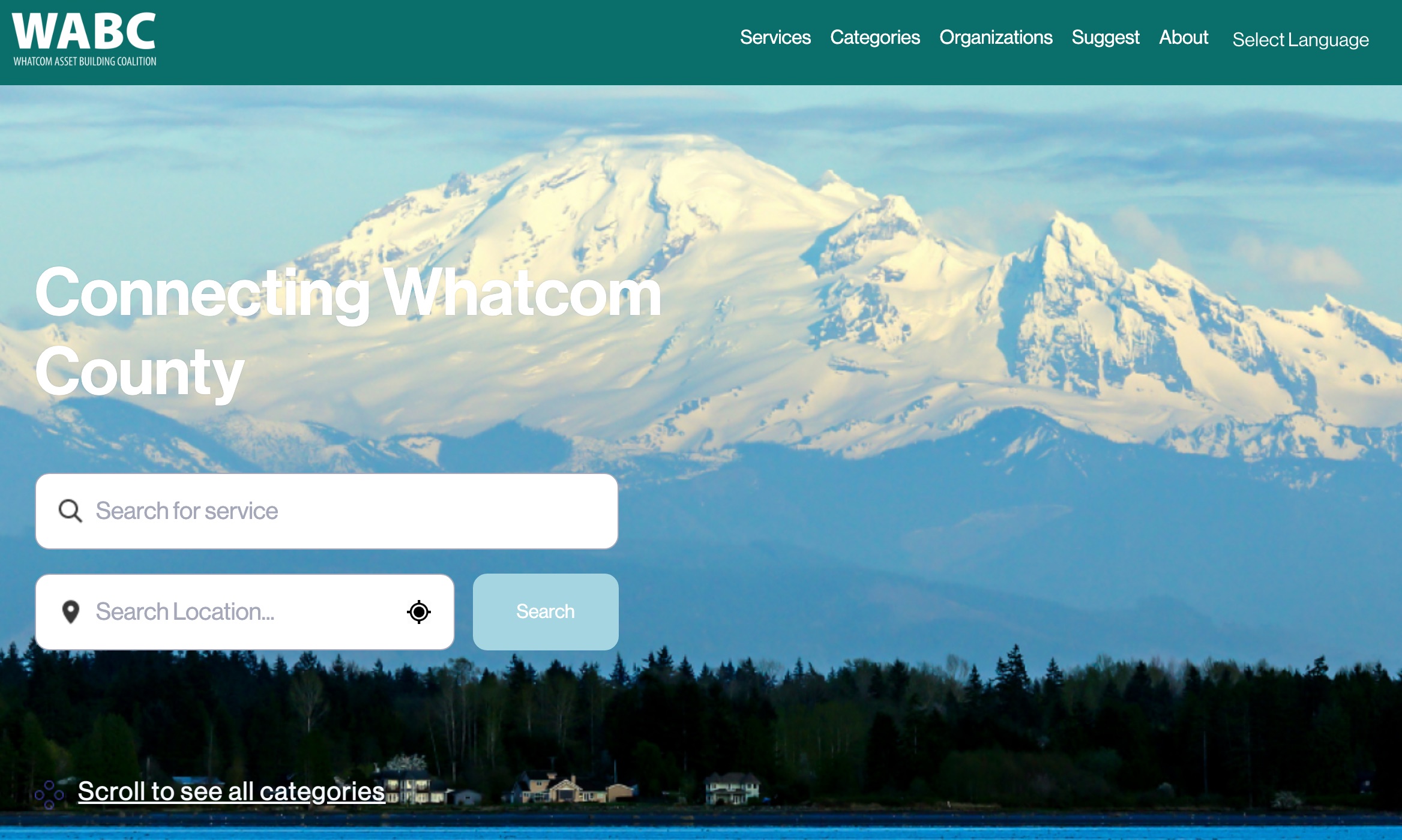This post is brought to us by Kristi Slette, Secretariat of the Whatcom Resource Information Collaborative in Washington state. Welcome, Kristi!
Whatcom County in Washington state – the northwesternmost county in the continental U.S. – is a resourceful community with many collaborative community-based organizations that serve residents in need.
For many years, the leadership and staff from many of these organizations have voiced a desire to improve the accessibility and reliability of information about resources available in our community. In the past, this desire sparked several attempts to develop a centralized resource directory – but in each instance, our vision was hampered by the complexities of this challenge. We all shared the same goal, but different organizations had different needs and interests. When it came time to address all of them in one single website, we struggled to move forward together.
Learning from the past
In 2019, a series of community assessments and strategic planning sessions once again surfaced the need for a resource directory as a priority for Whatcom County, and a coalition of human and social service organizations convened to address this challenge with fresh eyes. This time, we sought to learn from previous efforts.
Through extensive dialogues with three different groups – social service providers who had been involved in the previous resource access initiatives, the conveners of those initiatives, and managers of current resource directories in our area – we perceived a set of key themes: the importance of leadership, human capacity, and buy-in from the community.
Through this reflection, we recognized that technology – which had previously been our primary focus – is actually only a part of the solution. Rather than just designing a new tool, our new initiative would need to focus on building the capacities and relationships that will be needed to ensure that any such resource information system is adaptive, sustainable, and trustworthy.
Building capacity for collaboration
In 2021, having prioritized improvements in access to resources for families with young children, the Whatcom County Health Department provided some seed funding to support our new initiative to establish a resource directory information system for the county. This time, we resolved to build a system that would be collectively “owned” by our community as a whole.

Along the way, we talked with a few technology vendors about how we might develop a shared database system. Most were happy to offer us complex feature specs with high price tags. These conversations felt like the same path we’d taken before, and we knew how it was likely to end up.
Then one of the members of our group saw a presentation about Open Referral at the All-In convening, and reached out to Greg Bloom to come speak with us.
Greg showed us examples of open source websites and resource directory data management tools developed by members of the Open Referral community – like ORServices by Sarapis, and the Open Referral Airtable. These are free tools that could be easily adapted to local needs. This was exciting to us – but even more importantly, we appreciated Open Referral’s message about the importance of cooperative institutional arrangements.
So in 2022 we partnered with Open Referral. Open Referral provided us with standards, technical assistance and a trustworthy tech contractor to help us get a database and technology up and running quickly. Simultaneously, we worked together through a holistic strategic process. With a leadership group representing many stakeholders in our diverse community, we focused most of our energies on the process of designing an organizational model that would promote trust by establishing a clear statement of our values and principles, a set of dedicated stewardship responsibilities, and accountable processes.
Six months later, this past summer, the newly-named Whatcom Resource Information Collaborative (WRIC) approved our governance structure in the form of a charter.
We are excited to have buy-in from key government agencies and partners in the community who are committed to this model of collective governance and community stewardship.
Designing structure for community ownership: the Data Utility Model
The core of our model is built upon the concept of a “Data Utility,” which provides resource information as a service to everyone in the community – like a power or gas company. The Data Utility is operated day-to-day by a “Data Steward,” which is responsible for its administration and operations. The Data Utility is collectively owned by our community as represented through the WRIC, and the Data Steward receives resources and direction to make it all work.
Our county’s community action agency, Opportunity Council, has long managed a resource directory as part of its role of Community Resource Center, which provides information and assistance to residents in need. During the relaunch of our initiative in 2021, Opportunity Council’s resource directory was still managed in an outdated FileMakerPro – and they were ready to rebuild it entirely. Our community collaboration helped make it happen in a way that would benefit the Opportunity Council’s Resource Center as well as the broader community.
The Opportunity Council now plays the designated (and funded) role of Data Steward, managing the technology and contents of the Data Utility on behalf of the WRIC and our community at large.
Tech is cheap.
We’ve recently introduced the prototype of a Whatcom Resource Directory website and content management system, at about a tenth of the cost which a software vendor had previously quoted us.

Working with Sarapis, Opportunity Council first tested a deployment of the Open Referral Airtable – and agreed that it posed a major improvement on their previous system (FileMakerPro). Sarapis helped Opportunity Council extract, transform, and load their ‘old’ resource directory data into this system. Then they helped us rapidly develop and deploy a basic, searchable directory website as a proof of concept. This site is available in multiple language translations, can be searched by organization, service or keyword.

In addition to being more user friendly (and free to re-use and adapt – we paid only for Sarapis’ time in tech support & training, data import, and website customization, and hosting), this system also has an API that enables access to this data for third-party systems which may be developed by other organizations who wish to deliver this information in their own way to those they serve.
This approach positions our Resource Information Collaborative to provide not just a single website, but resource data as a service to any website, app, call center, or other information system that might help Whatcom residents in need. Our vision is to increase access so that community members will find reliable, accurate, and consistent information no matter where they turn. No wild goose chase necessary!
Making it all work – together
With Open Referral’s support, the WRIC has developed our own policies (based on documents established by other Open Referral pilots) – including a style guide for content of our database, a workflow for updating resource records and an inclusion and exclusion policy to guide decision-making about what resources, organizations or entities will be made available to the public.
Using open source technology enables us to take this journey step-by-step. We are able to quickly build tools and interfaces which can be improved iteratively through ongoing testing and observation of user experience. WRIC members, as knowledgeable users of the system, can participate in advancing the functionality of the data utility through involvement in testing and providing feedback. To me, this feels far preferable to other alternatives in which vendors provide us with proprietary tools over which we have little control.
In a healthy and connected community, hope rises! We’re raising hope by setting winnable goals: we are now working to ensure that our Data Utility will be properly funded, and along the way we will expand the scope of resources included in our system, build capacities to provide continuous quality improvement of that information, enhance our website and API functionality, and develop new partnerships throughout our region and the state at large. These systems need to be adaptive and accountable to us. We are grateful for the privilege to do this work together, and we’d love to know that our work blazing this trail can serve as an example for others taking similar paths.


Leave a Reply